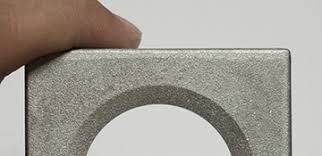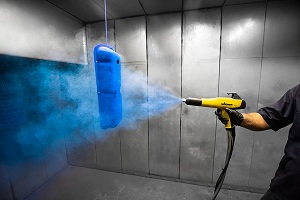Surface treatment of lathe parts
What is surface treatment? The definition of surface treatment.
Many kinds of machining produce surface texture. The process is usually optimized to ensure that the resulting texture is usable. If necessary, an additional process will be added to improve it. The latter process may be grinding (abrasive cutting), polishing, lapping, abrasive blasting, honing, electrical discharge machining (EDM), milling, lithography, industrial etching/chemical milling, laser texturing, or other processes.
Sandblasting --- one way of surface treatment
Sandblasting will add a uniform matte or satin surface treatment to the machined parts, removing tool marks.
During the sandblasting process, a pressurized air gun is used to bombard parts with small glass beads to remove some material and smooth the surface. Can cover key surfaces or features (such as holes) to avoid dimensional changes.
Sandblasting is mainly used for visual purposes. This is a manual process, so the result depends to a certain extent on the skill of the operator. The size of the air pressure and the size of the glass beads are the main process parameters. The size of the glass beads is different (from thick to very thin), just like the size and grade of sandpaper.

Anodizing (Type II and Type III) --- one way of surface treatment
Anodizing adds a thin ceramic layer on the surface of metal parts to protect them from corrosion and wear. The anode coating is non-conductive, has high hardness, and can be dyed in different colors. Anodizing is only compatible with aluminum and titanium.
Anodizing is carried out in type II and type III, the parts are immersed in dilute sulfuric acid solution, and a voltage is applied between the component and the cathode. The electrochemical reaction consumes the material on all exposed surfaces of the part and converts it to hard aluminum or titanium oxide. Masks can be used on surfaces with critical dimensions (such as threaded holes) or surfaces that must remain conductive to prevent anodization.
Anodized parts can also be dyed in various colors (such as red, blue, black or gold) before sealing, which gives them a beautiful surface treatment.
By changing the current, anodizing time, concentration and temperature of the solution, coatings with different thicknesses and densities can be formed:
Type II anodizing (transparent or color)
Type II anodization, also known as "standard" or "decorative" anodization, can produce coatings up to 25 μm thick. The typical coating thickness depends on the color. For parts dyed black, the thickness can be between 8-12 μm, and for transparent (undyed) parts, the thickness can vary between 4-8 μm.
Type II anodizing is mainly used to produce smooth and beautiful parts, and provides good corrosion and limited wear resistance.
Anodized Type III (hard coating)
Type III anodizing is also known as hard anodizing , which can produce coatings up to 125 μm thick. Unless otherwise stated, the thickness of a typical Type III anode coating is 50 μm.
Type III anodizing treatment produces a high-density thick ceramic coating with excellent corrosion and wear resistance, suitable for functional applications. Compared with type II anodizing, it requires stricter process control, so the cost is higher.

Powder coating--- one way of surface treatment
The powder coating adds a thin layer of protective polymer to the surface of the part. Powder coating is a strong, wear-resistant coating that is compatible with all metal materials and can be used in combination with sandblasting to produce parts with smooth, uniform surfaces and excellent corrosion resistance.
The process of powder coating is similar to spraying, but "paint" is a dry powder rather than a liquid. First coat the part with an optional phosphating or chromate coating to improve its corrosion resistance, then use an electrostatic "spray" gun to coat it with dry powder, then at a high temperature (usually at 200°C) In the oven) curing.
Multiple layers can be applied to produce thicker coatings, with typical thicknesses ranging from about 18 μm to a maximum of 72 μm. There are many colors to choose from.

How to choose suitable surface treatment for your product? Surface finishing processes can be classified according to how they affect the workpiece:
|
Adding And Altering |
Removing And Reshaping |
Mechanical Finishing |
|
Blanching |
Abrasive blasting |
Abrasive blasting |
|
Case hardening |
Sandblasting |
Sandblasting |
|
Ceramic glaze |
Burnishing |
Burnishing |
|
Cladding |
Chemical-mechanical |
Grinding |
|
Electroplating |
planarization (CMP) |
Mass finishing processes |
|
Galvanizing |
Electropolishing |
Tumble finishing |
|
Glazing |
Flame polishing |
Vibratory finishing |
|
Knurling |
Gas cluster ion beam |
Polishing |
|
Painting |
Grinding |
Buffing |
|
Passivation/Conversion coating |
Different types of surface treatment forms that you can quickly understand.
|
Surface Treatment Type |
Concepts and Applications of the process |
|
Anodic Oxidation Process |
Anodic Oxidation Process is an electrochemical method which helps in producing an oxide coating on a metallic surface. The oxide layers are formed by electrolysis of the metal built into anodes in an electrolytic solution. Anodizing film is absorbent therefore coloring and dyeing is applied to the material used in different structures such as ships and bridges. |
|
Chemical Process (Chemical Coating) |
It’s a coating which is done by chemical reaction or electrochemical of metals, creating a visible coat containing the metal composite. This treatment is done on steel and iron, and chromic acid coating on aluminium. It applications are metal coloring, corrosion protection, and priming of surfaces to be painted to increase paint adhesion. This coating gives economical protection against corrosion and an exterior fitting for painting and powder coating. |
|
Electroless plating |
It is a method of plating in which a chemical is used instead of electric. During the plating a piece which is to be plated is wrapped up in a reducing solution that, when catalyzed by a particular materials, converts metal ions to metal that creates a deposit on the part. Electroless plating is very popular in plastic plating particularly in Printed electronic circuits. Most popular Electroless plating technique is nickel plating, although copper silver and gold can also be used. |
|
Electroplating |
It is a treatment process which provides coating of a thin metal layer on another metal using electrolysis to enhance the metal corrosion resistance. Metal generally used in plating are Chrome, Copper, Gold, Nickel, Silver, Tin, and Zinc. This treatment is applied in a wide array of fields from small parts to heavy machinery in automobiles, and home appliances for functional plating and etc. It main purpose is to enhance the appearance anti corrosion property, special surface property and much more. |
|
Hot Dipping |
It is a process in which products are dipped in dissolved aluminium, tin, zinc, lead and solder to form surface metallic layer. This is done by passing the metal through molten zinc at a temperature of 860°F (460°C) to create zinc carbonate. HDG is a budget friendly and can be done on a large scale. Most common example is zinc plating on steel towers. |
|
Metallic Cementation |
This is a technique for framing surface combination layers by covering the surfaces of warmed metals and metal dissemination in the meantime. There is a strategy for warming the pre-plated items, just as warming the items in powdered type of metal to be covered. |
|
Painting |
There are shower painting, electrostatic painting, electrodeposition painting, powder painting strategies, and are commonly utilized for surface improvements, hostile to rusting and against erosion. As of late, useful painting, for example, electro-conductive painting, non-glue painting, and greasing up painting are in dynamic employments. |
|
Surface Hardening |
This is a procedure of metal surface modification, for example, carburizing, nitriding, and enlistment solidifying of steel. The procedures enhance against wear properties and weariness quality by changing metal surface properties. |
|
Thermal Spraying |
Metals and earthenware production (oxides, carbides, nitrides) powders are flown into blazes, circular segments, plasma streams to be disintegrated and be splashed onto surfaces. Ordinarily utilized as paint preliminary bases on bigger auxiliary articles, and clay warm splashing for wear avoidance. |
|
Vacuum Plating |
it is a procedure of vacuum disposition applied to distribute thin layers through the vaporization of the interested film onto the given surface. It is also known as ion assisted deposition (IAD) or physical vapor deposition (PVD). There are different types of vacuum plating like Cathodic arc deposition, Evaporative deposition, Laser deposition, Sputter deposition. This plating is used in Cutting tools, Semiconductor components |
Applications of surface treatment
The surface treatment industry plays an important role in extending the life of metals, such as in building materials and automotive frames. It is also used in equipment that enhances protection or reduces waste of other raw materials (for example, electroplated metal for food preservation tanks, electroplating for automotive and aerospace braking and suspension systems, electroplating of precision fuel injectors for automotive engines to reduce fuel Burning etc.). .
Major environmental impacts related to water and energy consumption, raw material use, groundwater discharge, and surface, liquid and solid waste.
Since most surface treatment methods are based on water, the use of water and its regulation are the primary considerations, because it also affects the consumption of raw materials and its impact on the environment. Both the pipe end method and the in-process method affect the quantity and quality of wastewater, as well as the type and quantity of solid and liquid waste produced.
Summary
This article is about surface treatment, the type of heat treatment, the application of heat treatment.


